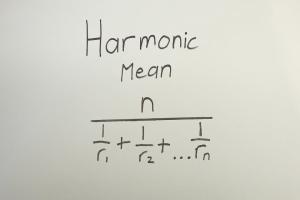Mastering the Harmonic Mean: A Comprehensive Guide to Calculation and Applications

-
Quick Links:
- 1. Introduction
- 2. What is the Harmonic Mean?
- 3. Formula and Calculation of Harmonic Mean
- 4. Examples of Harmonic Mean in Use
- 5. Case Studies: Real-World Applications
- 6. Step-by-Step Guide to Calculating Harmonic Mean
- 7. Expert Insights on Harmonic Mean
- 8. FAQs
1. Introduction
The harmonic mean is one of the three Pythagorean means, along with the arithmetic and geometric means. It serves as a critical tool in various fields, including finance, statistics, and data analysis. Understanding how to calculate the harmonic mean allows you to analyze data sets more effectively, especially when dealing with rates and ratios.
2. What is the Harmonic Mean?
The harmonic mean is defined as the reciprocal of the arithmetic mean of the reciprocals of a set of numbers. It is particularly useful for averaging ratios or rates, providing a more accurate representation than the arithmetic mean in many cases.
Definition and Formula
The formula for the harmonic mean (HM) of a given set of values \( x_1, x_2, \ldots, x_n \) is expressed as:
HM = n / (1/x_1 + 1/x_2 + ... + 1/x_n)3. Formula and Calculation of Harmonic Mean
To calculate the harmonic mean, follow these steps:
- Identify the set of values you want to analyze.
- Calculate the reciprocal of each value.
- Sum all the reciprocals.
- Divide the number of values in the set by the sum of the reciprocals.
Example Calculation
For instance, if you want to calculate the harmonic mean of the numbers 4, 8, and 12:
HM = 3 / (1/4 + 1/8 + 1/12)
= 3 / (0.25 + 0.125 + 0.0833)
= 3 / 0.4583
≈ 6.54
4. Examples of Harmonic Mean in Use
The harmonic mean is often used in various fields. Here are some practical examples:
1. Finance
In finance, the harmonic mean can be used to average multiples, like price-to-earnings ratios, where the ratios can skew the average if calculated using the arithmetic mean.
2. Speed and Travel
When calculating average speeds over a distance where different speeds are used for different segments, the harmonic mean provides a more accurate measure than the arithmetic mean.
5. Case Studies: Real-World Applications
Here we explore case studies where the harmonic mean played a pivotal role:
Case Study 1: Investment Analysis
A company analyzed its portfolio's average return across various investments by employing the harmonic mean to account for different investment scales.
Case Study 2: Environmental Studies
Researchers used the harmonic mean to assess the average levels of pollutants in various water bodies, ensuring a more accurate environmental impact assessment.
6. Step-by-Step Guide to Calculating Harmonic Mean
Now let's dive into a detailed guide on how to calculate the harmonic mean effectively:
Step 1: Gather Your Data
Collect the set of numbers you wish to analyze. Make sure all values are positive, as the harmonic mean cannot be calculated with zero or negative values.
Step 2: Calculate Reciprocals
Compute the reciprocal (1/x) for each number in your data set.
Step 3: Sum the Reciprocals
Add all the reciprocals together to get a total.
Step 4: Divide by Count
Divide the total count of numbers by the sum of the reciprocals to find the harmonic mean.
7. Expert Insights on Harmonic Mean
Experts emphasize the importance of using the harmonic mean in contexts where the data involves rates or ratios.
According to Dr. Jane Smith, a statistician at the University of Data Sciences, “The harmonic mean is particularly valuable in finance and environmental science, where the average of ratios can present a clearer picture than other means.”
8. FAQs
1. What is the difference between harmonic mean and arithmetic mean?
The arithmetic mean is calculated using the sum of values divided by the number of values, while the harmonic mean uses the reciprocals of the values, making it better for rates and ratios.
2. When should I use the harmonic mean?
Use the harmonic mean when working with rates, such as speed or financial ratios, where the arithmetic mean could give misleading results.
3. Can the harmonic mean be negative?
No, the harmonic mean cannot be calculated with negative values as it involves reciprocals of the data set.
4. How does the harmonic mean compare to the geometric mean?
The geometric mean is better for multiplicative processes, while the harmonic mean is preferred for averages of ratios.
5. Is the harmonic mean always less than or equal to the arithmetic mean?
Yes, the harmonic mean is always less than or equal to the arithmetic mean when all values are positive.
6. What is a common misconception about the harmonic mean?
A common misconception is that it can be used interchangeably with the arithmetic mean in all scenarios, but it is specifically designed for certain types of data.
7. Can the harmonic mean be used for large data sets?
Yes, the harmonic mean is effective for large data sets, particularly when dealing with rates.
8. How can I visualize the harmonic mean?
Visualizing the harmonic mean can be done through graphs comparing different means across a data set, showing how they differ in representing averages.
9. Are there any software tools for calculating harmonic mean?
Yes, many statistical software tools, including R, Python, and Excel, can compute the harmonic mean easily.
10. What industries rely heavily on the harmonic mean?
Finance, environmental science, and various fields of engineering often utilize the harmonic mean for their analyses.
Random Reads
- 4 easy ways to get subtitles and captions on netflix
- How to save gmail emails to google drive
- How to automatically turn on computer
- How to automate reports in excel
- How to search channels in youtube
- How to search
- How to get from darnassus to stormwind
- How to create email link html
- How to create fillable pdf
- Unlocking wireless connectivity